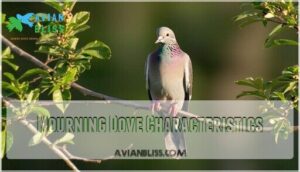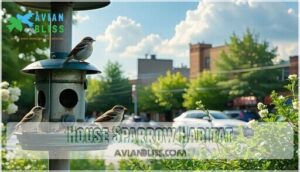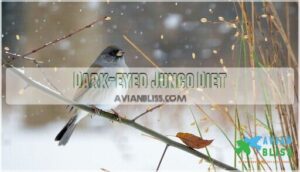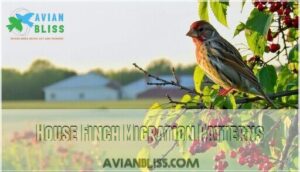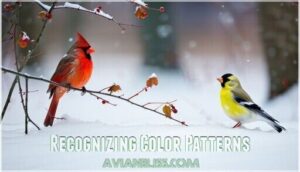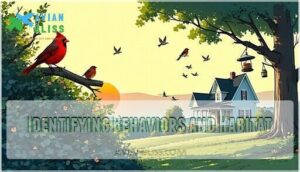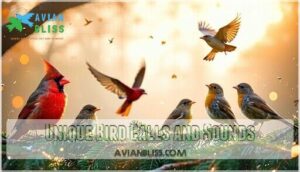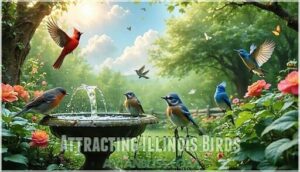This site is supported by our readers. We may earn a commission, at no cost to you, if you purchase through links.
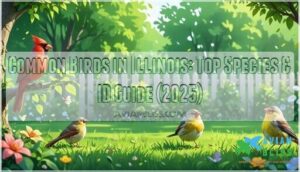
The Northern Cardinal’s bright red plumage makes it unmistakable, while American Robins hop across lawns hunting earthworms.
American Goldfinches turn brilliant yellow in summer, and Downy Woodpeckers drum rhythmically on tree bark.
House Sparrows chatter in flocks, Mourning Doves coo softly at dawn, and Dark-eyed Juncos flash white tail feathers when they fly.
These seven species represent the backbone of Illinois’s avian community, thriving in both urban neighborhoods and rural landscapes.
Recognizing their unique behaviors and preferred habitats reveals the secret to successful backyard birdwatching adventures, which is key to enjoying the avian community and understanding their unique behaviors.
Table Of Contents
- Key Takeaways
- Common Illinois Birds
- Year Round Resident Birds
- Illinois Bird Identification
- Attracting Illinois Birds
- Seasonal Illinois Birds
- Frequently Asked Questions (FAQs)
- What are the most common birds in Illinois?
- How many birds are in Illinois?
- What birds live in a forest in Illinois?
- Are red winged blackbirds common in Illinois?
- What do birds look like in Illinois?
- What is the biggest bird in Illinois?
- What is the most common bird in northern Illinois?
- How can I identify a bird in my yard?
- What are the small GREY and brown birds in Illinois?
- What is the most common bird you see near your home?
- Conclusion
Key Takeaways
- You’ll find seven core species year-round – Northern Cardinals, American Robins, American Goldfinches, Downy Woodpeckers, House Sparrows, Mourning Doves, and Dark-eyed Juncos form Illinois’s backyard bird backbone
- Size, shape, color, and behavior are your identification keys – Notice overall proportions, wing spans, beak shapes, and distinctive color patterns like the Cardinal’s red plumage or Goldfinch’s bright yellow
- Strategic feeding setups attract more species – Use tube feeders for goldfinches, suet feeders for woodpeckers, platform feeders for cardinals, and combine with native plants and clean water sources
- Seasonal patterns reveal migration timing – Summer brings warblers and orioles in May, fall migration peaks in September-October with thousands of birds, while winter residents like juncos arrive in November
Common Illinois Birds
You’ll spot Illinois’s most common birds right in your backyard, from the brilliant red Northern Cardinal to the cheerful American Robin.
These year-round residents and seasonal visitors offer excellent opportunities for beginning birdwatchers to practice identification skills.
Northern Cardinal Habits
Why do Northern Cardinals stick around your yard year-round while other Illinois bird species migrate south? These non-migratory Illinois backyard birds maintain consistent territories and feeding patterns throughout all seasons.
Male cardinals establish 1-4 acre territories during breeding season, defending them through aggressive displays and territorial behavior.
Male cardinals fiercely defend their territories with aggressive displays and vocal duels during breeding season.
- Nesting Habits: Females build cup-shaped nests 1-3 meters high in dense shrubs using twigs and grasses
- Feeding Patterns: Diet consists of 70% seeds, favoring sunflower and safflower seeds at feeders
- Song Structure: Males produce up to 24 distinct song types for territory defense and communication
- Mating Rituals: Monogamous pairs often maintain bonds across multiple breeding seasons
- Territorial Behavior: Males use crest raising, wing flicking, and vocal duels to defend bird habitats
American Robin Characteristics
You’ll recognize this American Robin by its distinctive rusty red breast and dark head with white throat markings.
These illinois bird species showcase fascinating Feather Patterns – males display brighter coloration during Breeding Seasons while females appear more subdued.
Their melodic Bird Songs consist of cheerful "cheerily-cheer-up" phrases.
Robin Habitat includes yards, parks, and woodlands where they hunt earthworms.
Nesting Habits involve building cup-shaped nests in trees, making them easy targets for illinois bird watching and bird identification among common illinois birds.
American Goldfinch Migration
Following autumn’s chill, American Goldfinch migration begins as these bright yellow birds form massive flocks heading south.
Following autumn’s chill, massive goldfinch flocks streak south in nature’s great migration spectacle.
Illinois bird migration peaks during September when goldfinches abandon northern breeding patterns for warmer regions.
Migration timing depends on food sources—when thistle and sunflower seeds become scarce, flocking behavior intensifies.
Goldfinch routes stretch from Canada to Mexico, making illinois migratory birds essential stopover visitors for common illinois birds enthusiasts watching bird migration patterns.
Downy Woodpecker Behavior
You’ll recognize Downy Woodpeckers by their distinctive high-pitched whinnying calls that descend in pitch.
Their drumming behavior serves dual purposes – communication and foraging strategies.
Downy Woodpeckers display fascinating pecking habits, systematically searching bark crevices for insects.
They prefer nesting sites in dead tree limbs, excavating new cavities annually.
They’re backyard favorites, readily visiting suet feeders during Illinois winters, and play a role in woodpecker conservation.
Understanding their role in this conservation is essential for maintaining ecological balance in Illinois’ ecosystems.
Year Round Resident Birds
You’ll find thirteen bird species that call Illinois home year-round, making them reliable sights whether you’re filling feeders in January or watching nest-building in June.
These permanent residents have adapted to survive Illinois’s variable climate and provide consistent birdwatching opportunities through every season.
Mourning Dove Characteristics
You’ll recognize mourning doves by their soft gray-brown bird plumage and distinctive black spots on their wings.
These Illinois birds produce melancholy Mourning Dove Calls that sound like gentle cooing.
During dove nesting season, they build flimsy platforms in trees or shrubs.
Their pointed tails and streamlined bodies make them excellent fliers, though dove migration patterns vary by individual birds across different Illinois bird identification guides.
House Sparrow Habitat
House Sparrows thrive in urban habitats, making your backyard their permanent home.
These adaptable birds prefer nesting sites near human activity, from building eaves to dense shrubs.
You’ll spot them frequenting backyard feeders and parking lots across Illinois.
Unfortunately, habitat loss hasn’t affected House Sparrows like native species—they’ve mastered city living, competing with native birds for resources in illinois bird habitats, and have become a part of the urban habitats.
Dark-eyed Junco Diet
Dark-eyed Juncos adapt their bird diet seasonally in Illinois.
Winter brings heavy seed preferences – over 75% of their intake focuses on grass seeds, chickweed, and crabgrass.
Summer shifts dramatically toward insect eating, with beetles and caterpillars comprising 30-50% of consumption.
These foraging habits include scratching leaf litter and visiting feeders for millet.
Fruit consumption occurs occasionally in late summer, while suet feeding attracts them to backyard setups during harsh weather.
House Finch Migration Patterns
Unlike their seed-eating cousins, House Finch populations in Illinois show unique Seasonal Patterns that’ll surprise you.
These adaptable backyard birds don’t follow traditional Migration Routes like most species.
House Finch Behavior includes:
- Year-round residency in suitable Finch Habitat
- Short-distance movements based on food availability
- Flocking behavior during harsh winter conditions
- Dispersal patterns following breeding season
- Urban adaptation reducing migration needs
Illinois bird sightings reveal House Finches rarely migrate long distances.
Bird Tracking studies show they’re permanent illinois birding favorites, making illinois bird migration less relevant for this resilient species.
Illinois Bird Identification
Successfully identifying birds in Illinois requires attention to four key characteristics that distinguish each species.
Start by noting a bird’s size and shape, then observe its color patterns, behavior, and habitat preferences—these details will help you confidently identify the most common species in your backyard.
Noting Bird Size and Shape
Size and shape form the foundation of successful illinois bird identification.
Start by noting overall body proportions – is the bird compact like a sparrow or elongated like a robin?
Wing span provides essential clues, with broad wings suggesting soaring species while narrow wings indicate fast fliers.
Beak shapes reveal feeding habits instantly, and bird silhouettes against the sky help distinguish families, while feather patterns on wings and tails offer additional identification markers for illinois birds, including fast fliers.
Recognizing Color Patterns
Color identification makes illinois bird identification surprisingly straightforward.
Red birds like Northern Cardinals stand out against winter snow, while American Goldfinches flash bright yellow plumage during breeding season.
Blue feathers on Blue Jays catch your eye instantly, and black wings help distinguish Common Grackles from crows.
Focus on dominant colors first, then notice secondary markings for accurate backyard birds identification.
Identifying Behaviors and Habitat
While observing bird behavior, you’ll notice distinct patterns that reveal species identity.
Cardinals prefer dense shrubs for nesting sites, while robins choose open branches near homes.
Watch feeding patterns—goldfinches flock at seed sources, juncos forage on woodland floors.
Migration routes bring seasonal visitors like warblers through illinois birding trails. Understanding these bird habitats helps with accurate bird identification and supports illinois bird conservation efforts.
Unique Bird Calls and Sounds
Learning bird calls transforms your Illinois bird watching experience into an acoustic adventure. Each species has unique vocal signatures – cardinals whistle clear notes, robins sing liquid trills, and goldfinches twitter in flight.
Sound mimicry masters like mockingbirds copy dozens of calls, while woodpeckers drum distinct patterns. Frequency ranges vary dramatically, from tiny wren songs to deep owl hoots, creating nature’s symphony across Illinois.
Understanding the bird songs guide is essential for identifying species by their distinctive vocalizations. This knowledge helps in making the most out of your bird watching experience, turning it into a truly unique experience.
Attracting Illinois Birds
You can transform your yard into a bird haven by offering the right combination of food, water, and shelter.
Strategic placement of feeders, native plants, and water sources will attract Illinois’s diverse bird species year-round.
Types of Bird Feeders
Different feeder types attract specific Illinois birds effectively.
Each design serves unique feeding behaviors and preferences.
- Tube Feeders – Perfect for goldfinches and chickadees seeking sunflower seeds
- Suet Feeders – Essential for woodpeckers like downies and red-bellied species
- Platform Feeders – Ideal for ground-feeding cardinals and sparrows
- Nyjer Feeders – Specialized thistle dispensers that goldfinches absolutely love
Strategic feeder placement enhances your backyard birding success rate substantially.
Understanding tube feeder options is vital for attracting the desired bird species.
Planting Native Illinois Plants
Five Native Plant Choices transform your yard into a bird haven.
Illinois Wildflowers like Purple Coneflower and Black-eyed Susan provide seeds for finches, while Big Bluestem grass offers nesting material.
Bird Friendly Gardens flourish with Serviceberry and Elderberry shrubs that produce berries attracting illinois bird species.
Local Seed Selection supports Prairie Restoration efforts, creating sustainable backyard birding opportunities that benefit illinois wildlife and bird conservation.
Using native plant seed sources is essential for maintaining biodiversity in these gardens.
Providing Clean Water Sources
Water features attract more illinois bird species than any single feeder.
You’ll need consistent birdbath maintenance – scrub weekly and refill daily. Shallow dishes work better than deep ponds for most backyard birding needs.
Position water sources near cover but away from predator hiding spots. Rain barrels provide steady water supply while supporting bird conservation efforts.
Monitor water quality regularly, especially during hot summers when illinois waterbirds visit frequently. Regular use of a birdbath cleaner helps maintain healthy water conditions.
Creating Brush Piles for Shelter
Behind every thriving backyard habitat lies a simple truth: birds need cover to survive.
Creating brush piles from your yard cleanup transforms garden debris into essential wildlife shelter for illinois bird species. These natural structures provide bird nesting sites, protection from predators, and windbreaks during harsh weather.
Stack branches loosely, creating gaps where backyard birds can dart through. Your pile becomes a miniature illinois bird sanctuary, supporting native species year-round.
By incorporating native plants and using proper bird friendly habitat techniques, you can further enhance the attractiveness of your backyard to local bird species.
Seasonal Illinois Birds
Illinois’ bird populations shift dramatically throughout the year, with distinct species dominating each season.
You’ll observe summer migrants like Baltimore Orioles and Indigo Buntings from May through August, while winter residents such as Dark-eyed Juncos and American Tree Sparrows arrive in November and stay through March.
Summer Bird Migration
Summer brings waves of migrating Illinois bird species through the state’s corridors.
Peak warbler migration occurs in early May, while summer flocks of orioles and buntings arrive throughout late spring.
Key Summer Migration Patterns:
- Warbler Migration peaks during the first two weeks of May with 30+ species
- Bird Routes follow the Mississippi Flyway through Illinois river valleys
- Summer Flocks of chimney swifts and purple martins arrive by early May
- Feather Molting occurs in goldfinches before their late June nesting period
- Avian Travel timing depends on warm southerly winds accelerating movement
Winter Bird Habits
Winter’s grip transforms Illinois birding as cold weather drives behavioral changes in resident bird species.
Dark-eyed Juncos descend from northern forests, joining permanent residents like Northern Cardinals and Downy Woodpeckers.
Winter foraging becomes critical – you’ll spot flocks huddling in bird roosts during frosty mornings.
These illinois bird species adapt remarkably, with increased feeder visits and energy-conserving behaviors across snowy landscapes throughout midwest winters.
Spring Bird Patterns
March marks the beginning of spring migration for Illinois songbirds returning from wintering grounds.
You’ll witness remarkable changes as migratory birds establish territories and begin nesting habits across Illinois bird sanctuaries. Understanding the role of year round residents is essential for identifying species during this period.
Here’s what to expect during spring bird migration patterns:
- Early arrivals like red-winged blackbirds appear in wetlands by March
- Feather molting occurs as birds develop bright breeding plumage
- Flock behavior shifts from large winter groups to paired territories
- Nesting habits intensify with Midwest bird species selecting prime locations
Fall Bird Migration Patterns
Fall migration transforms Illinois into a bustling highway for migratory birds.
September peaks with warblers, grosbeaks, and tanagers streaming south, while October brings sparrows, ducks, and hawks.
These seasonal changes create spectacular viewing opportunities as Illinois bird species follow ancient migration routes toward warmer climates.
| Migration Month | Primary Species | Peak Numbers | Notable Behaviors |
|---|---|---|---|
| September | Warblers, Nighthawks | Thousands daily | Active dawn feeding |
| October | Sparrows, Hawks | Broad-winged flocks | Thermal soaring |
| November | Ducks, Loons | Peak waterfowl | Raft formations |
| December | Northern Species | Stragglers arrive | Winter territory setup |
The table highlights the primary species and their notable behaviors during each month, showcasing the diversity of bird life in Illinois during the fall migration, with species like warblers and hawks being particularly notable for their broad-winged flocks and thermal soaring behaviors.
Frequently Asked Questions (FAQs)
What are the most common birds in Illinois?
You’ll spot Northern Cardinals, American Robins, and Blue Jays year-round in Illinois backyards.
House Finches, Mourning Doves, and American Goldfinches also frequent feeders regularly, making them reliable residents you can observe daily.
How many birds are in Illinois?
Here’s what’ll surprise you about Illinois bird diversity: you’ve got approximately 450 native species documented by the Illinois Ornithological Records Committee.
Making your state a remarkable avian hotspot with year-round residents and seasonal migrants, is a fact that highlights the state’s diversity.
What birds live in a forest in Illinois?
You’ll find woodpeckers like Downy and Hairy varieties thriving in Illinois forests.
Pileated Woodpeckers prefer large mature forests, while various warblers and the Dark-eyed Junco also call these wooded areas home.
Are red winged blackbirds common in Illinois?
Like crimson badges of honor decorating wetland territories, red-winged blackbirds thrive throughout Illinois.
You’ll spot these territorial defenders year-round in marshes, prairies, and backyard feeders, making them one of the state’s most abundant species.
What do birds look like in Illinois?
Illinois birds showcase remarkable diversity – you’ll see bright red cardinals, sunny yellow goldfinches, sleek black crows, and striking blue jays alongside brown-streaked sparrows and distinctive woodpeckers with their bold patterns.
This sentence is already a complete concept and does not require further separation.
What is the biggest bird in Illinois?
Towering silently above you, Trumpeter Swans are the largest bird by weight in Illinois.
They’ve a wingspan of almost 6 feet (8 m) and weigh around 25 pounds (3 kg).
These magnificent waterfowl dwarf all other species in the state.
What is the most common bird in northern Illinois?
You’ll spot American Robins everywhere in northern Illinois backyards—they’re the region’s most abundant bird.
These rusty-breasted songsters dominate suburban lawns, parks, and neighborhoods year-round, making them your most reliable feathered neighbors.
How can I identify a bird in my yard?
Every backyard detective needs keen observation skills.
Look for size, shape, color patterns, and behavior.
Notice the bill shape – thin for insects, thick for seeds.
Check tail length, wing markings, and head features like crests or eye rings for positive identification.
What are the small GREY and brown birds in Illinois?
You’re likely seeing Dark-eyed Juncos, which have gray heads and backs with white undersides, or House Sparrows with their brownish-gray plumage and stocky build.
What is the most common bird you see near your home?
Looking at your backyard like a miniature ecosystem, you’ll likely encounter the Northern Cardinal most often.
These striking red birds (males) and brownish females frequent feeders year-round, making them Illinois’s most visible backyard residents.
Conclusion
Picture yourself sipping coffee as a Northern Cardinal flashes past your window—classic proof of common birds in Illinois.
By observing plumage, vocalizations, and feeding behaviors, you’ll identify species like Downy Woodpeckers or American Goldfinches with confidence.
Use field guides, note habitat preferences, and listen for unique calls.
With the right feeders and native plants, your backyard becomes a living lab.
Now, you’re ready to analyze, identify, and enjoy Illinois’s diverse avian community every season.
- https://en.wikipedia.org/wiki/List_of_birds_of_Illinois
- https://dnr.illinois.gov/education/wildaboutpages/wildaboutbirds/wildaboutbirdssparrows.html
- https://bwdmagazine.com/travel/regions/10-highlight-birds-illinois/
- https://gl.audubon.org/news/illinois-birds-need-wetlands-we-must-protect-them
- https://www.bbc.com/future/article/20191211-crows-could-be-the-smartest-animal-other-than-primates

